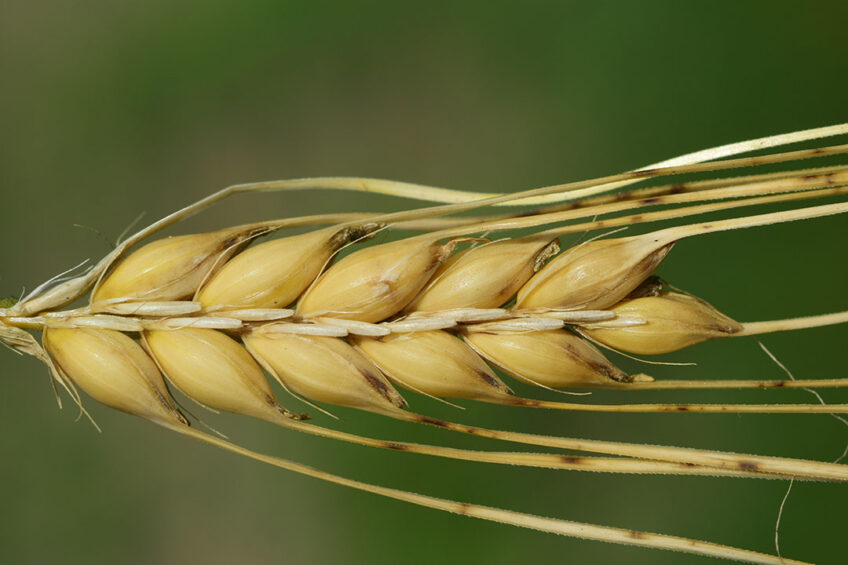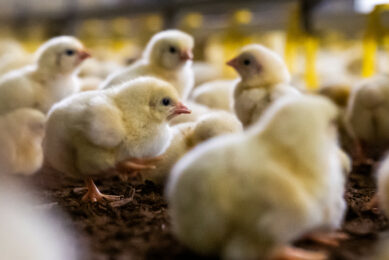Genetic engineering of barley feed enzymes benefits laying hens

A new study published in the Plant Biotechnology Journal shows supplementation of a basal diet of laying hens with genetically engineered barley seeds, enhances protein and phosphorus digestibility and egg quality while reducing environmental impact.
Reports show that about 66% of the barley seed produced in the world is used as animal feed. However, the endosperm cell walls of barley grains are characterised by the presence of β-glucans and arabinoxylans, 2 major anti-nutritional materials in monogastric animals shown to increase chyme viscosity and reduce the rate of digestion and absorption of nutrients in the small intestine. Given that feed ingredients are structurally complex, a multi-enzyme preparation, rather than a single enzyme, provides a feasible approach to enhancing nutrient utilisation in poultry diets. It is worth mentioning that if cereal seeds contain sufficient enzymes, there would be no need for supplementation with exogenous enzyme additives. Non-supplemented feed would significantly reduce feed costs and simplify feed processing and diet formulation. However, according to the researchers carrying out the current study, there are limited studies on the genetic engineering of multiple feed enzymes in cereal seeds.
Current process to obtain feed enzymes
At present, feed enzymes are usually obtained through the fermentation of fungi, bacteria, and other microorganisms. It should be noted that the manufacturing technology used to isolate feed enzymes after fermentation not only increases the cost of application but also results in a sharp decline in the activity of these enzymes. In addition, studies have shown that high temperatures during raw material processing can result in the breakage of some water-dispersing bonds in the enzyme protein molecules, ultimately changing their molecular conformation and activity. The current study confirms the use of an alternative approach through genetically modifying plant feed enzymes for direct use in animal feedstuff.
Multi-enzyme genetic engineering
Genetically modified plants containing complex or multiple feed enzymes could be a cost-effective alternative approach to the costly manufacture of exogenous feed enzymes. In this study, researchers co-expressed 3 commonly used feed enzymes (phytase, β-glucanase, and xylanase) in barley seeds using the Agrobacterium-mediated transformation method and generated a new barley germplasm. The genes for phytase, β-glucanase, and xylanase were isolated from Yersinia mollaretii, Pectobacterium parmentieri, and Aspergillus kawachii, respectively. This allowed high-level accumulation of these enzymes in the grains.
Expression of enzymes in transgenic barley
For the successful production of feed enzymes in barley grain, the stability of the enzyme in grains during post-harvest storage is an important aspect. The results of the current study showed that the activities of all 3 feed enzymes were stable for at least 6 months post-harvest, even when stored at 37°C. The researchers further demonstrated that transgenic barley seeds express phytase, β-glucanase, and xylanase together in endosperm without affecting seed germination. The phytase activity in transgenic seeds reached about 4000 U, whereas the β-glucanase and xylanase activities reached about 26,000 U/kg seed.
Genetic engineering does not reduce nutritional quality
Scanning electron microscopy (SEM) results showed that the transgenic barley was morphologically indistinguishable from wild-type barley grown under identical conditions. Specifically, there were no differences in the starch structure of transgenic plants and wild-type or normally produced seeds. However, compared to wild-type barley, the contents of phytic acid and β-glucan in transgenic barley decreased by about 37% and 84%, respectively. Protein is one of the main grain components that affects nutritional quality. The total protein was quantified to determine the effect of the increased feed enzymes in the transgenic seeds on the nutritional quality of the barley. Results showed that the content of protein in the transgenic seeds was in the same range as the wild-type seeds, meaning that genetically increasing feed enzymes in the seeds did not reduce the nutritional quality of barley.
Transgenic barley improves egg quality
A laying hen feeding trial was conducted to evaluate the effects on animal growth performance of the complex feed enzymes expressed in the transgenic barley. To this effect, flour obtained from transgenic seeds was added to basal animal diets and compared to 2 diets:
- a control/unsupplemented diet and,
- a diet supplemented with exogenous enzymes (phytase, β-glucanase and xylanase).
The results revealed that layers fed with basal diet (control group) were inferior in growth to those fed a basal diet in which the wild-type barley was replaced with transgenic barley. The strength of the eggshells in the transgenic barley group after 15 – 20 days of feeding increased by 10.0% – 11.3%, a level that was similar to that of the group fed a basic diet containing feed mixed with exogenous multi-enzymes (250 U phytase, 2000 U β-glucanase, and 2500 U xylanase). The weight of eggs from the transgenic barley group also increased by 5.6% – 7.7% compared to the control group.
Enhancing phosphorus and protein digestibility
After feeding the laying hens with transgenic barley, both phosphorus and protein digestibility were significantly improved compared to the control group. This improvement was similar to the one observed in the group supplemented with exogenous multi-enzymes (250 U phytase, 2000 U β-glucanase, and 2500 U xylanase). The excretion of phosphorus in faeces obtained from the transgenic barley group dropped by more than 50% compared to the control group. Improvement in protein digestibility was attributed to phytase which acts on the protein-phytate complex, making the protein available for digestion and utilisation by the birds.
Modulation of the gut microbiome
In this study, the richness and diversity of intestinal microbiota were promoted in layers fed with transgenic barley compared to layers in the control group, a finding that was similar to layers fed with exogenous multi-enzyme additives. Supplementation with transgenic barley enhanced the beneficial Rikenellaceae (Alistipes and Rikenella) bacteria in the caecum of chickens. However, researchers recommended future studies utilising molecular technologies to fully elucidate the mechanism through which enzymes exert changes on the intestinal microbiome. “Specifically, the combined approach of metaproteomics, metatranscriptomics, and metabolomics is a useful tool for understanding the relationship between feed enzymes and the intestinal microbiota,” they said.
Conclusion
In conclusion, the co-expression of YmAPPA, PceglA, and AkxynC genes in transgenic barley seeds resulted in remarkable increases in phytase, β-glucanase, and xylanase activities, respectively. Supplementation with only 8% enzyme-containing transgenic seeds in the basal diet of laying hens reduced indigestible carbohydrates, improved the availability of phosphorus, and reduced the impact of animal production on the environment. “Collectively, our findings suggest that the transgenic barley seeds produced in this study can be used as an ideal feedstuff in laying hen diets.”











